Thomas McKelvey Cleaver describes how the Tempest provided the fighter core of the British Occupation forces in Germany and served in India to become the initial equipment for the air forces of India and Pakistan.
All seven Tempest squadrons were in Germany for VE-Day. 122 Wing’s 3, 56, 80 and 486 Squadrons were part of 83 Group based at B152 Fassberg, while 135 Wing’s 33, 222 and 274 Squadrons in 84 Group were at B109 Quackenbrück. After a few days spent celebrating survival, they turned to a routine of training flights, patrols, flag-waving sorties and occasional massive flypasts in celebration of the Allied victory.
Tempests remain
While many 2nd TAF squadrons were disbanded or returned to the UK, the Tempest units were untouched. 486 Squadron was posted to 125 Wing at B160 Kastrup, in Denmark the day after VE-Day. This meant exchanging war-torn Germany, with a population trying to come to terms with the defeat of their ravaged homeland, for enthusiastic, welcoming, citizens, with no curb on ‘fraternisation.’ In July 1945, 125 Wing was disbanded and replaced by 122 with its wartime Tempest squadrons, other than 486, which joined 124 Wing at B158 Lübeck, but not before a massive air display was flown on July 1, attended by the Queen of Denmark.
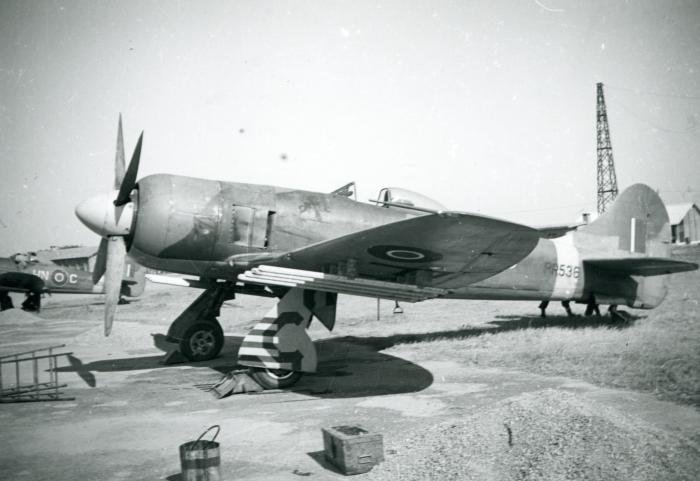
2nd TAF was renamed the British Air Force of Occupation (BAFO) on July 15, 1945. Rumours flew about new postings of experienced personnel to Burma, which gained some substance when two Typhoon squadrons were flown back to the UK for conversion to Tempest IIs and a probable transfer to South East Asia Command (SEAC). However, the war came to an abrupt end in August before this could happen.
Roland Beamont arrived back in England from his enforced seven-month sojourn at Stalag Luft III in late May and found he was immediately shortlisted to command the Tempest II wing that was planned to accompany the RAF’s Tiger Force of long range Lancasters to the Far East, where the fighters would be based on Okinawa for Operation Olympic, the planned invasion of Japan in November 1945.
Beamont went so far as to have Tempest II MW835 adorned with his initials, R-B, as had been his Tempest V a year earlier - before this came to an end in August. He went on to the Central Fighter Establishment at RAF Tangmere, where he joined the newly-formed Tactics Branch, staffed by fellow ex-POWs Douglas Bader and Robert Stanford Tuck, joined by RAF Fighter command veterans Bobby Oxpring, Frank Carey, Robin Johnson, Colin Grey and Pete Brothers, bringing their considerable experience as the outstanding RAF wing commanders of the war to review and revise tactics for fighter operations and to evaluate captured enemy aircraft. Beamont spent an enjoyable few months flying Bf-109s, Fw-190s, Mustangs, Spitfires, Meteors and anything else with wings he could lay hands on, before leaving active service and moving on to an outstanding 40-year career as one of the leading test pilots of the British aviation industry.
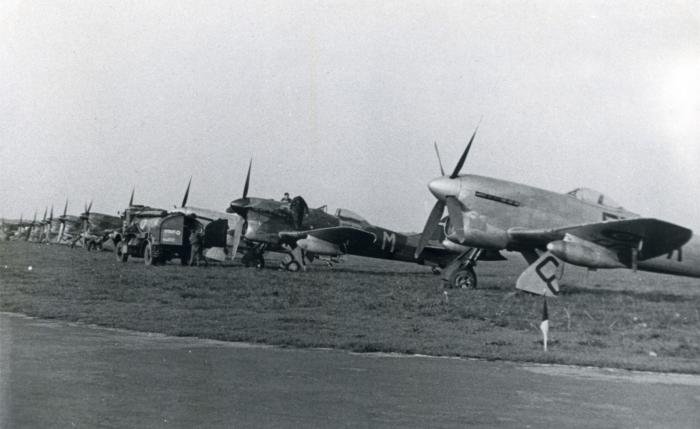
Winding down
With the war now officially over around the world, the Germany-based Tempest squadrons began winding down. Treble two returned to Chilbolton to convert to the Tempest II before taking part in the Battle of Britain flypast over London on September 15. Several weeks later, they moved to Molesworth for re-equipment with the Gloster Meteor.
By the end of September 1945, 84 Group was the main Tempest user, with 135 Wing composed of 3, 33, 56 and 174 (formerly 274) Squadrons, while 83 Group had 41 and 80 Squadrons at Lübeck. All Typhoon squadrons were gone and the Tempest squadrons assumed the fighter-bomber role, finally putting the Tempest’s rocket-firing capability to use. While ‘zero-length’ RP launching rails were now available, the BAFO squadrons continued to use the Mk IIIa lightweight rails that had been fitted to Typhoons since the end of 1944.
In October 1945, 56 Squadron was visited by a Tempest II for demonstration purposes. The squadron would re-equip with the newer Tempest in 1946. The German winter set in, reducing opportunities for flying with weather over 19 days in November too poor for flying. Come the spring of 1946 Fighter Command reclaimed 41 and 56 Squadrons, with the existing units being renumbered as 26 and 16 Squadrons, respectively.
Tempest II arrives
The Tempest V had always been regarded as an interim type, with the Mk II considered the ultimate Tempest. The fighter was set to replace the aging Hurricanes and lend-lease Thunderbolts in in Southeast Asia. In April 1945, six aircraft (MW801 to MW806) were flown out to Khartoum in Sudan for intensive flying trials.
The first Mk IIs that had been stored at MUs were released for service while these tropical trials were in progress, with the first aircraft going to 183 and 247 Squadrons, which had been formerly equipped with Typhoons and had been withdrawn from 2nd TAF in Germany for re-equipment and service in Burma. With the end of the war coming three weeks after 183 Squadron received its first Tempests, re-equipment plans changed and the Mk IIs that were now pouring off the production lines were delivered straight to MUs for temporary storage. Bristol’s production order was cut back to 50 aircraft, of which 20 were actually assembled by Hawker from Bristol-built components, while Hawker’s production orders were reduced. In the end, only 452 Tempest IIs were produced.
The Tempest was not included in Fighter Command’s post-war plans, which were jet-oriented. 247 Squadron soon became the first squadron to equip with the Vampire F.1 in April 1946, while 183 was renumbered 54 and spent the six months it kept its Tempests as a conversion unit for pilots destined for the Tempest squadrons in the Middle East.
Tempests to India
The Tempest re-equipment programme for squadrons in SEAC was activated again in December 1945. Over the next 18 months 180 Tempest IIs were sent out to India. They were reassembled and prepared for service at 320 MU at RAF Drigh Road, near Karachi. 5, 20, 30 and 152 Squadrons were scheduled for conversion onto the Tempest II. Squadron Leader Frank Murphy, now a Hawker Aircraft test pilot following a successful wartime tour flying with 486 Squadron, was sent out to 329 MU to brief the unit’s test pilots on the Tempest II.
He also demonstrated the aircraft for the squadrons as they re-equipped, and recalled: “I spent a short time with each, giving demonstrations, lectures and so on. They were quite experienced squadrons, but they had some trouble with the Tempest at first because it was a difficult aircraft when landing, especially if you had a bit of a crosswind. The reason why it varied from the Tempest V was that the wider nose on the Tempest II for the radial engine made the airflow over the rear fuselage quite different when the tail dropped after landing, or when you made a three-point landing. The airflow over the fin was not enough to keep the aircraft straight and you had to use full rudder or sometimes brake. A high crosswind made the problem worse and a ground loop could result.
“Indian airfields were not very forgiving as they had monsoon ditches down each side, not far from the runway. So they had a lot of prangs, often wiping off undercarriage legs. The answer was to do a ‘wheeler’ landing, which give you time to line things up before the tail dropped or even, on occasions when a long runway was available, to land with less flap, when you’d get more air flow over the tail surfaces and the rudder was more effective.”
Thunderbolt-equipped 5 Squadron at Bhopal received its first Tempest IIs on March 5, 1946. Murphy gave a confidence-boosting demonstration for the squadron that was recorded in its official history: “A mere ten minutes but that was enough to impress on us all the versatility of this aircraft. To climb, loop and roll off the deck and the turning circle at 450 mph shook us all and if any doubts were held, they have now been dispelled.”
5 Squadron’s Flight Lt Harry Pears, a former Typhoon pilot, recalled: “Every pilot I met took to the Tempest II immediately and appreciated its ability in the ground attack role. Following a move to Puna, in real ‘brown job’ territory, the use of army ranges soon brought the squadron up to a high standard of live firing. Many live demonstrations were given to local army formations and others elsewhere in southern India. Tribal disturbances on the North West Frontier took the squadron to Risalpur and Peshawar, where again the use of firing ranges kept the shooting standard at a high level. Some dummy operations were flown over very mountainous terrain to scare the tribesmen and the odd sortie with solid RP heads and ball ammunition was undertaken.
“At Miramshah, a fort on the Northwest Frontier, the Tempests flew Road Open Day (ROD) patrols in support of convoys supplying outposts, along with visual checks of the outposts as the RAF units in India had done before the war. Armed aircraft were at standby during daylight hours every day and at the end of the day the Tempests were moved into the fort and placed in individual hangers originally built for the old Westland Wapitis.”
Two 320 MU test pilots, Flt Lts Douglas Coxhead and Barry Byrne, performed testing of newly-assembled Tempests and ferried the aircraft out to the squadrons. Coxhead, who had flown Tempest Vs with treble two in the last weeks of the war, recalled: “We lost some pilots here and there in India, but very few Tempest IIs went down. It was rough country. One test-pilot force-landed 12 miles from base and started to walk back and although we soon found his aircraft there was no sign of him. Later, ground searchers found a shoe and that was all. The Sind desert was no place to walk across at night.
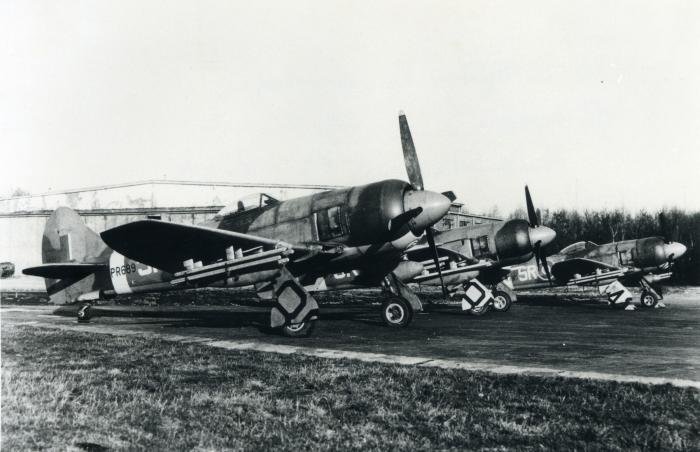
“Later, after I had been posted to 152 Squadron as a flight commander, I led a demonstration for the Staff College at Quetta, where a buckled fairing meant I had to fly all the way back at 190 mph, with the undercarriage down. As a result, I ran out of fuel and was forced to land at the old, deserted strip at Tank, where fortunately there was an abandoned Dakota from which I was able to drain some fuel. This was much to the delight of the local tribesman, who seemed to think I was milking the beast! They didn’t seem too keen to let me go, so as soon as I started the Tempest, with lots of smiling and waving, I wheeled it round and tore off without even fastening my straps!”
At the end of September 1946, the wartime Air Command South East Asia (ACSEA) was disbanded and the RAF units were reorganised under Air Command Far East. With the force reduced to peacetime requirements, India Command HQ ordered production of newly-arrived Tempests to cease on January 13, 1947, with the assembled fighters delivered to 307 MU for storage.
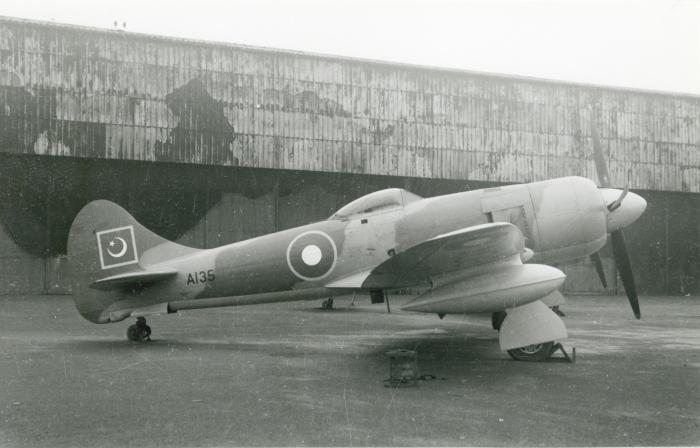
In India and Pakistan
In September 1946, 3 Squadron Royal Indian Air Force (RIAF) began equipping with the Tempest II, followed by 8 Squadron RIAF in November. In December 30 Squadron RAF disbanded, followed by No 152 in January 1947, with their aircraft transferred to the RIAF. By May 1947, 20 Squadron was the only RAF Tempest unit that was operational. RIAF 1 and 9 Squadrons re-equipped in May and June respectively.
With Partition looming, 20 Squadron disbanded on July 31, 1947, followed by 5 Squadron on August 1. Its Tempest IIs were handed over to the RIAF. When Partition occurred on August 15, 1947, all the RAF Tempest IIs were divided between the RIAF and the new Royal Pakistani Air Force (RPAF), with India receiving 124 Tempests and Pakistan 35. In 1951-52, both purchased more refurbished Tempest IIs from Hawker after the fighter left RAF service.
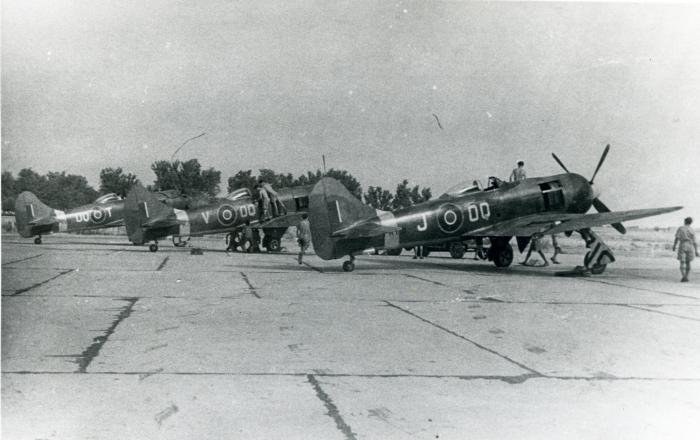
Tempest II in Germany
Following the equipment of the RAF in India with Tempest IIs, the BAFO Tempest V wings began re-equipping with Tempest IIs. 26 Squadron received its first Tempest IIs on June 19, 1946, at Gatow. The other two 135 wing squadrons received Mk IIs, but the 123 wing units, 3 and 80 Squadrons, stayed with Mk Vs until 3 re-equipped with Vampire F.3s and 80 with Spitfire F. 24s in 1948.
The Tempest squadrons engaged in flying exercises, weapons training, joint exercises with the army and practice at the APCs. The squadrons also rotated through Gatow, Berlin’s airfield in the British sector, where Allied airspace was strictly limited, and intrusions into Soviet territory, accidental or not, brought dispute. On March 16, 1947, WO Angus Mackay’s Tempest
had engine problems during a ground-controlled approach to Gatow. Mackay was fortunate to pull off a wheels-up forced landing in a large field, which turned out to be Soviet territory. An RAF ground party retrieved the pilot and the gyro gunsight before the Russian guards arrived.
During 1947, a crisis built at the port of Trieste on the border between Yugoslavia and Italy, which both claimed. During Operation Diagram 135 wing moved to Zeltweg, in Austria, which was a little over 30 minutes’ flying time from Trieste. To demonstrate their presence, four Tempests led by 26 Squadron’s Flight Lt Jack Frost flew down the Adriatic, then returned at very low level, just clearing the rooftop of Yugoslavian president Tito’s HQ. The deployment lasted a month, after which the wing returned to Fassberg. The re-equipment of 3 and 80 Squadrons in 1948 ended Tempest operations in Germany.
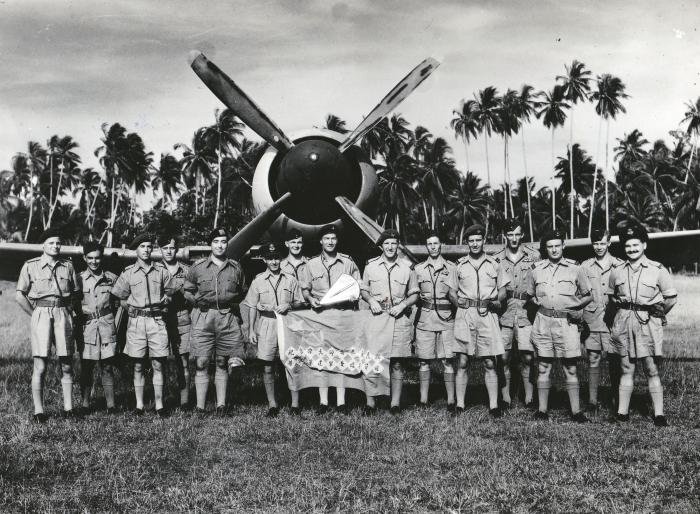
In the Middle East
While the Tempest II had been seen as the desired variant, it was also recognised that the fighter’s number would be limited by the availability of Centaurus engines, which meant development and production of the Sabre-powered Tempest would continue. The new Sabre Mk V had nearly ten per cent more power output than the Tempest V’s Sabre II. Fitted in the Tempest V prototype HM595, this became the prototype Tempest VI, which first flew on May 9, 1944. The new engine’s 2,340hp required more cooling capacity, which was provided by removing the oil cooler and carburettor air intake from the radiator centre. That space was filled with additional radiator area while the carburettor air intakes were repositioned in the inner wing leading edges and the oil cooler was fitted behind the radiator.
Early in the Tempest VI’s development, the RAF decided it would be optimised for the Middle East. Tempest V EJ841 was modified to Mk VI standard for trials at the A&AEE and with the new Napier Sabre, while the tropicalised Mk V EJ759 was sent to Khartoum for engine cooling and air cleaner trials. Engine cooling was quickly shown be inadequate and a subsidiary oil cooler was fitted in the leading edge of the starboard wing similar to the Tempest II. The air cleaner was similar to that fitted on production Typhoons and was installed beneath the fuselage. During ground running and taxiing, when sand and dust were a problem, carburettor air was drawn in via the filter system while retraction of the undercarriage automatically transferred to air from the leading edge intakes. Lowering the undercarriage reversed the sequence and a manual switch in the cockpit could override this in the event of a dust-laden atmosphere. The aircraft was equipped with desert survival gear, including two cylinders of water mounted behind the pilot’s head armour.
Orders were placed with Hawker Langley for 306 aircraft in a contract that originally covered production of Tempest I aircraft. The total was reduced to 250 and then cut further to 142. The first production Tempest VI was not delivered until July 1945 and the first seven were retained by Hawker and Napier for trials. Full performance and cooling trials were performed with NX119 at Khartoum between December 1945 and February 1946. With the more powerful Sabre V, the Tempest VI had a top speed of 438mph at 17,800ft and a service ceiling of 38,000ft. Deliveries took place throughout 1946, mostly to 20 MU at RAF Aston Down. The Tempest VI was cleared to carry 250lb, 500lb and 1,000lb bombs, or eight 60lb RPs. Unlike the other Tempests, the Tempest VI was fitted with Mk VIII RP (zero-length) launchers. In addition, 45- or 90-gallon drop tanks could be carried underwing.
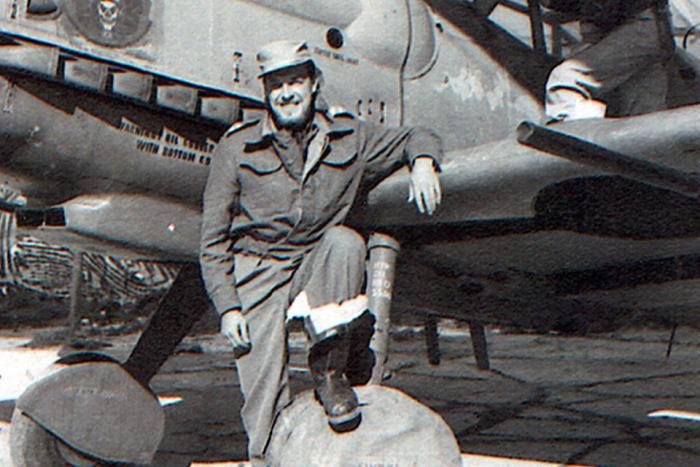
At the end of World War II, RAF fighter and fighter bomber squadrons remaining in the Middle East were equipped with Spitfires, Mustangs, Mosquitos and even Hurricanes. These were replaced with the Tempest VI and the Spitfire F.R. XVIII. Tempests were not available until the end of 1946. While some wartime Typhoon and Tempest pilots remained in the RAF, there was no Tempest conversion unit. No 54 Squadron, the sole Tempest squadron in the UK, relocated to Molesworth and provided Tempest experience for 19 pilots with postings to the Middle East. In December, Tempest VIs were flown out to Fayid, in Egypt.
249 Squadron at Habbaniya, Iraq, was first to equip with the new Tempest, with the first one arriving on December 23, 1946. The squadron had shrunk to a ‘cadre,’ with only eight Tempests, ten pilots and 50 other personnel. 6 Squadron’s first Tempests arrived at Nicosia, Cyprus on December 31. The squadron had the distinction of being the last operational Hurricane unit in the RAF, operating Hurricane IVs until the Tempests arrived. 213 Squadron, also at Nicosia, received its first Tempest VIs on January 21, 1947. The squadron found the Tempests were plagued by oil leaks and generally demanded a lot more maintenance than the Mustang IVs they replaced.
Meanwhile, 8 Squadron in Aden received Tempest VIs in March 1947. These soon saw action when they made a punitive raid on the village of Al Husein, where a Government agent had been shot. Policing operations by the Tempest units followed the pattern of the pre-war colonial squadrons. Strikes against dissident tribes saw leaflets dropped 48 hours in advance warning of the event. Thus the Tempests mostly bombed empty villages.
In July 1947, 8 Squadron carried out two rocket attacks against the fort at Bal Harith, losing a Tempest and its pilot, Flying Officer Freddie Tanner, when the fighter flick-rolled three times and crashed, the result of a high-speed stall during pull-out. In November, 8 Squadron carried out a small war against the Quteibi, a rebellious tribe that had extorted payment for safe passage through its area for years, but was now looting villages. Two-and-a-half days of attacks subdued the troublemakers. In 1940, three months of bombing had failed to achieve this result.
The Nicosia-based squadrons were assigned to 324 Wing in June 1947. In the coming months, the wing would move to Sudan and be based at Shallufa, Khartoum and eventually Deversoir, to deal with unrest. Typical of these assignments was 213 Squadron’s detachment of three Tempests and supporting ground crew to Asmara between late March and early May 1948 to support the King’s Own African Rifles in operations against the Shifta, lawless tribesmen robbing and terrorising communities southwest of Asmara, Eritrea. The support involved reconnaissance, communications, patrols and herding cattle back to their rightful owners.
In August 1948, 213 squadron left Khartoum for Mogadishu to cover another British withdrawal. 8 Squadron was particularly busy in October. Over 13 days, seven pilots flew 107 hours against the Mansuri in Wadi Mirria, attacking 16 forts and destroying 15 of them, firing 468 rockets with an average error later calculated as six yards!
Israeli War
249 Squadron at Habbaniya was kept on alert throughout the first half of 1948 because of unrest caused by the unstable situation in Palestine. On April 13, the unit sent four Tempests to Palestine, where trouble between Jewish and Arab factions might require their attention. They returned to Iraq on April 27 but were ordered back to Palestine during the build-up to the British withdrawal and declaration of the new state of Israel on May 15, 1948.
After 8 Squadron experienced several crashes over the summer of 1948, Middle East Command’s highly-decorated safety officer, Squadron Leader J R Baldwin – the leading Typhoon ace during the war – carefully tested the squadron’s Tempests and all were given a clean bill of health except for NX130/J, which was deemed to be a ‘rogue’ aircraft and despatched to 107 MU for storage. Squadron Leader F W M Jensen’s NX131/A was noted as being ‘an extraordinary aircraft’.
While Israel fought its War of Independence against the combined forces of Syria, Egypt, Jordan, Lebanon and Iraq, RAF forces were not directly involved until January 7, 1949 – the day a ceasefire between Israel and Egypt was due to commence at 1600hrs – when reconnaissance flights were mounted to investigate activity on the border. Four Spitfire FR 18s of 208 Squadron were attracted by smoke rising from an Israeli military column recently strafed by Egyptian Spitfires. The RAF aircraft were fired on by the Israeli gunners, who feared further attacks. Two Spitfires were hit, forcing one of the pilots to bail out. While the others circled with attention on the downed pilot, they were ‘bounced’ by two Israeli Spitfires flown by former Bell Aircraft test pilot Chalmers ‘Slick’ Goodlin and Canadian ace John McElroy. Tactical advantage and experience led to the three remaining British Spitfires being quickly shot down. WO P2 R Sayers was killed and two other pilots were captured by the Israelis, while one returned via Egyptian forces.
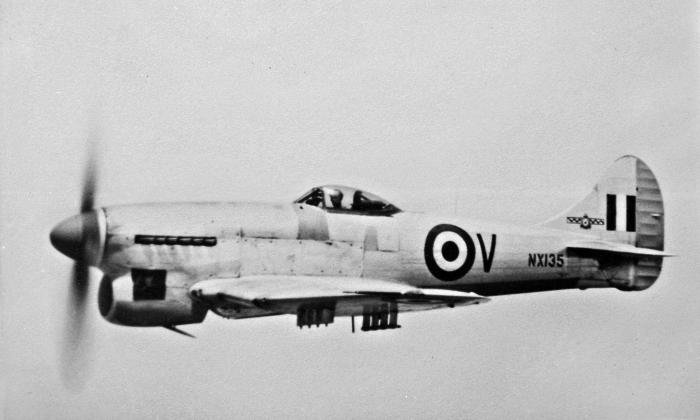
When it became apparent that the 208 Squadron patrol was not returning, four of the unit’s Spitfires were despatched to search for their colleagues. Tempests of 324 Wing at Fayid scrambled to provide an escort of 16 fighters. Seven Tempests from 213 Squadron led by the 324 Wing commanding officer, Group Captain A F Anderson, gave cover at 6,000ft while eight from 6 Squadron, led by its OC, Squadron Leader Denis Crowley-Milling, provided top cover at 10,000ft. At the northern end of the border, near Rafah, Anderson spotted four Spitfires diving on his section and called a break to starboard – the Israelis had mistaken the Tempests with their long-range tanks for bomb-carrying Egyptian Spitfires. 213’s Pilot Officer David Tattersfield was shot down, his Tempest spinning to the desert floor streaming smoke.
What should have been a one-sided encounter for the Tempests descended into black farce. Diving to intercept the opposing Spitfires, Crowley-Milling’s section found themselves unable to release their long-range tanks, severely hampering manoeuvrability against their more agile foe. As the other formations became involved, confusion increased since 208’s Spitfires had red spinners – as did the Israelis. When the Tempests did manage to get into shooting positions the pilots discovered they couldn’t open fire - their guns apparently uncocked, though 6 Squadron’s Flight Lt Brian Spragg did manage a few bursts at Ezer Weizman’s Spitfire, resulting in minor damage. Weizman hit one of the RAF fighters, most likely WO D ‘Sticka’ Liquorish’s Tempest, while two others were also damaged.
Later investigations found that 324 wing had been stood down before the scramble order came, with the result that the 213 Squadron ground crews had used the opportunity to remove and service the Tempests’ belt feed mechanisms. The failure of the long-range tanks to release was caused by ground crews tightening the cradle arms after each flight, putting increasing pressure on the release pins with the result it was virtually impossible to withdraw them with the Bowden cable operated from the cockpit. After the battle, 208 Squadron’s red spinners were quickly painted white.
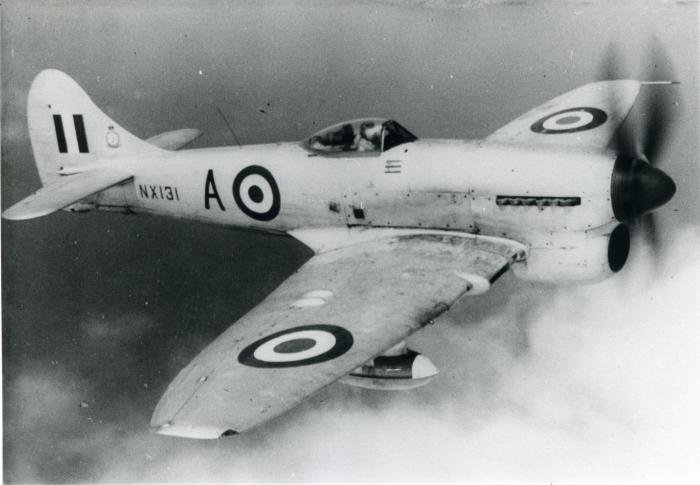
Leaving Middle East
249 Squadron was ordered in early March 1949 to join 324 Wing at Deversoir, which happened on March 29. Over the course of the summer, the Tempests, most of which had been delivered in the current ‘high speed silver’ scheme, were stripped of all paint and repainted in the new ‘desert’ scheme that was approved that August. The scheme had a disruptive pattern over the upper surfaces of dark earth and light slate grey (a greenish-grey colour), with the lower surfaces painted PRU blue. Shortly after this was complete, the first Vampire FB 5 jets arrived at 6 squadron on September 17, 1949. Following the completion of pilot conversion, Tempest operations ceased on November 12, 1949, other than ferry flights and disposal. The remaining Middle East squadrons continued operating Tempests into 1950.
On February 1, 1950, 249 squadron took part in exercises with the Fleet Air Arm, flying against Sea Furies and Fireflies. The exercises demonstrated the well-used Tempests were still superior to their opponents, being able to turn inside the Sea Furies and outrun the Fireflies.
Time ran out for the Tempest F.6 shortly after, with 213 squadron completing its conversion to Vampires by the end of March, while at the same time the last Tempests from 8 and 249 squadrons were flown to the UK for disposal, while 8 Squadron began operating Bristol Brigands and 249 converted to Vampires. With that, the Tempest F.6 disappeared from the RAF.
This article is from Tempest E-Magazine
Tempest, your all-new guide to the unsung power player compiled by the team behind Aeroplane, celebrates 80 years since Hawker’s piston-engine star took flight and details its story from concept to production and into combat.


